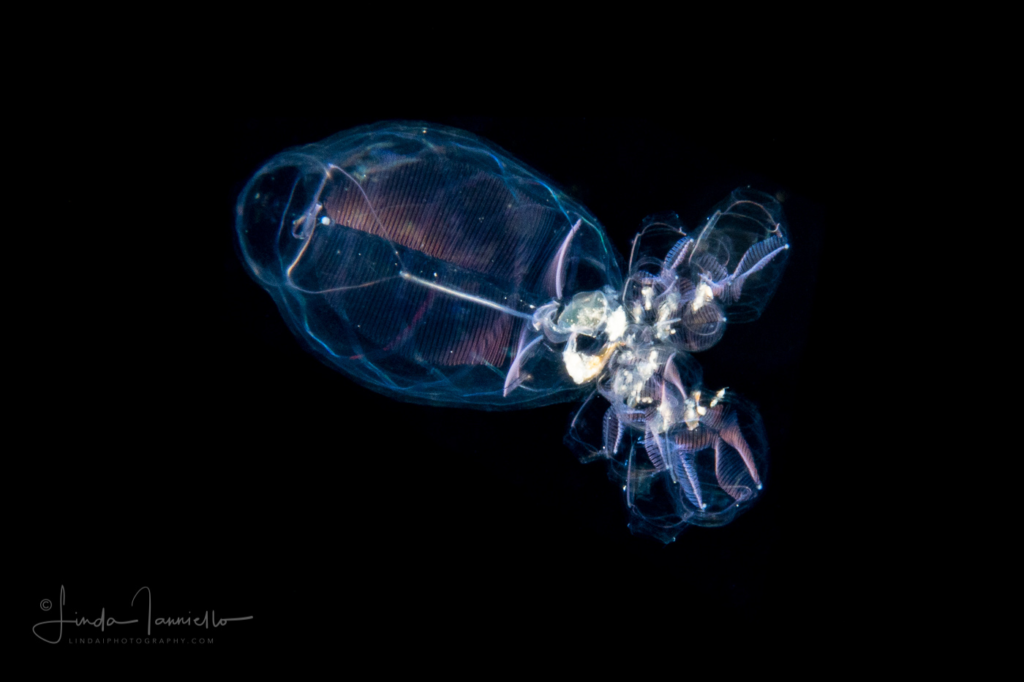Tunicates
Introduction
Tunicates, also known as ‘sea squirts’ are small, gelatinous creatures that live in our oceans. There are three main groups of tunicates, one group are sessile, they attach to a surface and do not move, but the other two are holoplankton and drift through the water column (Britannica, 2025). It may sound crazy, but they belong to the same phylum as humans (Chordata) as they possess a notochord! A notochord is just a rod used for support found in all members of Chordata. All tunicates filter feed, they suck in water and catch particles to use as food. They are very important in food webs as they eat tiny plankton and bacteria, then larger animals eat them, transferring the energy on (Johnson & Allen).
Doliolids

Doliolids are barrel shaped gelatinous creatures that are very important in our oceans. They filter feed which means they suck water in through an opening and catch particles to use as food. They use a mucous net to trap particles, then the water exists through another opening (Johnson & Allen, 2005). A cool feature doliolids have is they have the ability to remove unwanted particles which is very unusual but useful!
They have limited mobility but have tiny cilia which are used to propel themselves through the water (Holland, 2016). Their life cycle is complex and has many stages but the most important thing to note is their codophore. The codophore is a tail-like attachment found on some doliolids made up of baby doliolids!
The key features of doliolids are their barrel shape and muscular bands which look like stripes. These bands have a regular pattern, unlike salps which are more regular. In some images you may see a codophore attached to a doliolid, this can look different depending on what way the doliolid is orientated. Finally, doliolids do not have horns, if you are looking at a similar organism with horns it will be a salp.
Salps

Salps are very similar to doliolids but have a few key differences. One being they contract their muscular bands to help them move and push water through their bodies for feeding, they do not have any cilia. They also have a very complex life cycle, involving many stages that can be sexual or asexual! This is useful as it means they can rapidly increase their populations when needed (Johnson & Allen, 2005).
This quick increase in numbers is useful when they find blooms of phytoplankton (their food) as they can make use of them! Often large numbers of salps can be found near steady phytoplankton supplies (Holland, 2016). They are key in nutrient cycling, and their ‘poop’ is carbon-rich pellets which sink to the bottom of the ocean, this is an important process that helps remove carbon.
When identifying salps they can look very similar to doliolids, they have the same barrel shape. However, their stripes are not in a regular pattern, forming ‘x’ shapes, and they have horns. These two features set them apart from doliolids. Salps can also form long chains and individuals tend to be larger (Holland, 2016).
Appendicularians

Appendicularians can also be called larvaceans as they look similar to the larvae of tunicates, having a tadpole-like look to them. Appendicularians have a ‘mucous house’ which is a mucous that can cover the tail or the whole animal (Johnson & Allen, 2005). This ‘house’ helps them collect particles from the water; they can beat their tails to help move it around in the water.
Sometimes something might bump into the house, or particles build up so the appendicularian can leave! They have a ‘trap door’ they can use to exit, and they will grow another. This is a super cool and unique feature of these creatures. They can also make the house bioluminescent, attracting predators to an empty house, while they escape.
There is a circular ‘head’ region with tapers off from the body. The tail has a notochord running town it and when viewed from the side looks very thin. Their bodies can be pictured in an ‘S’ shape or can be straight. Sometimes their mucus house is visible.
Flash Card Practice
References
Encyclopedia.com. (n.d.). Appendicularia (Larvaceans). Retrieved March 27, 2025, from https://www.encyclopedia.com/environment/encyclopedias-almanacs-transcripts-and-maps/appendicularia-larvaceans
Encyclopædia Britannica. (2025, March 25). Chordate: Evolution, paleontology, anatomy. https://www.britannica.com/animal/tunicate/Evolution-and-paleontology
Holland, L. Z. (2016a). Tunicates. Current Biology, 26(4), R146–R152. https://doi.org/10.1016/j.cub.2015.12.024
Holland, L. Z. (2016b). Tunicates. Current Biology, 26(4), R146–R152. https://doi.org/10.1016/j.cub.2015.12.024
📌 Note: Only include one entry unless you’re citing two versions (e.g., with different content or DOIs). These appear to be duplicates, so you should remove one unless there’s a valid reason for both.
Johnson, W. S., & Allen, D. M. (2012). Zooplankton of the Atlantic and Gulf Coasts (2nd ed.). Johns Hopkins University Press.
Lindaiphotography. (n.d.). Doliolida planktonic tunicate [Photograph]. Retrieved May 16, 2025, from https://lindaiphotography.com/wp-content/gallery/black-water-jelly-like/Doliolida-Planktonic-Tunicate-08182018_068.jpg
Science Photo Library. (n.d.). Salp colony [Photograph]. Fine Art America. Retrieved May 16, 2025, from https://images.fineartamerica.com/images-medium-large-5/salp-colony-science-photo-library.jpg
Semenov, A. / Science Photo Library. (n.d.). Larvacean tunicate [Photograph]. Fine Art America. Retrieved May 16, 2025, from https://images.fineartamerica.com/images-medium-large-5/larvacean-tunicate-alexander-semenovscience-photo-library.jpg
